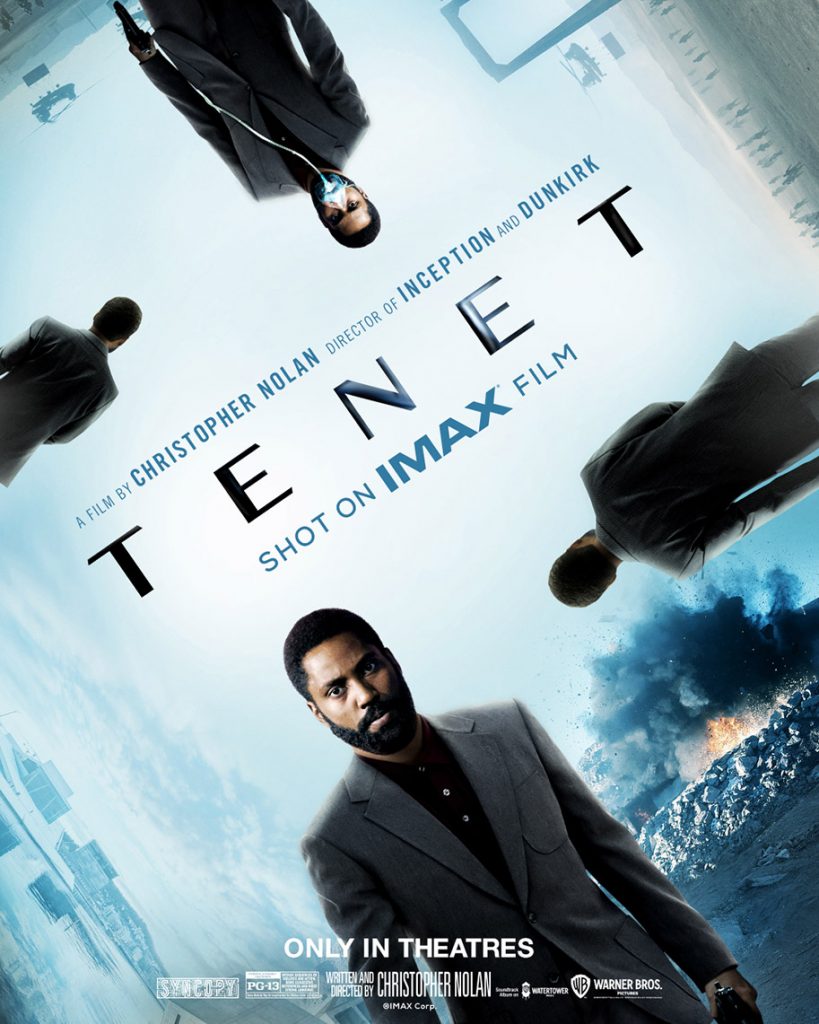In Review: Tenet
 by Ted Giese
by Ted Giese
Tenet’s lead character, the Protagonist, is a soldier with clandestine special training who is recruited into a temporal cold war to stop the future destruction of time and the material world. In this mysterious palindrome of a film he receives a code word “Tenet,” being told that it will “open the right doors, some of the wrong ones too.” Armed with this word and a gesture of interwoven fingers he embarks on a James Bond-esque globetrotting mission, complete with the glamorous damsel in distress; the billionaire villain and his henchmen bent on destruction; car chases; heists; secret identities; and a doomsday devise that must be found before the countdown runs out.
The film’s twist is that linear time—where the past moves into the future along a straight line of cause and effect—is inverted thanks to technology which allows the future to move backwards into the past, reversing the normal line of effect and cause. Sound confusing? At one point, a mysterious character named Neil asks the Protagonist if his head hurts. Many in the audience might be inclined to respond “yes” too.
Christian viewers may find use of the Sator word square of additional interest, as it has long been purported to a covert way in which Christians in the Roman army revealed themselves to each other.
The technology which reverses time also affects the properties of things in the physical world too—making oxygen poisonous to the lungs, for example, or making the heat of a fire so cold it can cause hypothermia. The dangerous impacts of the machine create a kind of tipping point, in which enough of time is affected that all the past and all the future collapse into each other, obliterating everything. A truly unpleasant man with the kill switch who must be stopped is the Russian arms dealer Andrei Sator. He holds an “If I can’t have the world, no one can” kind of attitude, rushing to assemble the device to flip the switch and destroy everything that ever was or ever would be.
The Sator Square
Director Christopher Nolan loves making puzzle movies, intricately assembled, and with carefully dovetailed “aha” moments—from 2006’s The Prestige, 2010’s Inception, to 2014’s Interstellar. Increasingly, Nolan seems interested in the way in which drama and tension can be heightened by what is observable and what is mysteriously hidden as time unfolds. This is why Tenet rewards multiple viewings. The second time through, viewers know what is about to happen and can see the puzzle pieces click together; all the dovetails join in real time. As many viewers lament the derivative nature of films with a preponderance of remakes, sequels, and re-imagined properties, Nolan seems on his own unique trajectory. If Tenet is derivative of anything, setting aside the Bond-esque plot, it is derivative of his own earlier works—a kind of compilation of his previous tricks. Yet even here he continues to give audiences something more with which to engage.
 This time, the mystery is built around the Sator square, an ancient Latin palindrome word square. A palindrome is a word that can be read the same forwards and backwards—an idea which fits perfectly into a film where past and future characters interact with each other and themselves in the present. A Sator word square contains five words which can be read backwards and forwards as well as up and down. All of the words in the Sator square show up in Nolan’s film indicating that their presence is not an accident: “Sator” is the name of the villain, “Arepo” the name of the forger, “Tenet” the code word for the Protagonist, “Opera” the location where the audience first sees inversion, and “Rotas” the location of the vault and time turnstile.
This time, the mystery is built around the Sator square, an ancient Latin palindrome word square. A palindrome is a word that can be read the same forwards and backwards—an idea which fits perfectly into a film where past and future characters interact with each other and themselves in the present. A Sator word square contains five words which can be read backwards and forwards as well as up and down. All of the words in the Sator square show up in Nolan’s film indicating that their presence is not an accident: “Sator” is the name of the villain, “Arepo” the name of the forger, “Tenet” the code word for the Protagonist, “Opera” the location where the audience first sees inversion, and “Rotas” the location of the vault and time turnstile.
Christian viewers may find use of the Sator word square of additional interest, as it has long been purported to a covert way in which Christians in the Roman army revealed themselves to each other. The word “Tenet” inside the square creates a cross. Likewise, in Nolan’s film, “Tenet” is at the heart of the salvation and of time itself—a biblical allusion to Christ and His sacrifice, which for Christians is the fixed centre point in time and history where forgiveness flows backward into the past and forward into the future.

Historically, the Sator square, which is its own mysterious puzzle, has also been rearranged to reveal a hidden anagram in the form of a Greek cross: “Pater Noster,” with a mirrored Alpha and Omega. “Pater Noster” are Latin for “Our Father,” the first words of the Lord’s Prayer. Alpha and the Omega are the first and last letters of the Greek alphabet, and are used in the Revelation of St. John to indicate Jesus’ temporal omnipresence, even His existence outside of time: “I Am the Alpha and the Omega, the First and the Last, the Beginning and the End” (Revelation 22:13).
Selfishness/Selflessness
The emotional core of Nolan’s film Tenet centres around Kat, the entrapped wife of villain Andrei Sator. She is held against her will by her husband who thinks she purposely passed off a forgery of a Goya drawing by a man named Arepo. In reality, she had only mistakenly passed it off as genuine. She desperately wants to keep in contact with their son and is willing to help the Protagonist if it means she can get away from Sator with her son. While she begins the film as a Bond-esque damsel in distress, she becomes an increasingly important piece of the puzzle necessary to resolve the plot. The Protagonist is not, as might be imagined, the film’s emotional core. He and Neil seem to float backwards and forwards in time without deep underlying character motivations until the end of the film. Even then, it becomes clear that the film’s end is really the middle of a potentially bigger story.
“Pater Noster” are Latin for “Our Father,” the first words of the Lord’s Prayer. Alpha and the Omega are the first and last letters of the Greek alphabet, and are used in the Revelation of St. John to indicate Jesus’ temporal omnipresence, even His existence outside of time: “I Am the Alpha and the Omega, the First and the Last, the Beginning and the End” (Revelation 22:13).
There are several things Christian viewers may want to think about in regard to Tenet. As Sator prepares to destroy all things in a nihilistic apocalypse, there is an interesting exchange between him and the Protagonist. Here Sator admits paying money for time in a kind of “deal with the devil” to extend his life. He also confesses knowingly bringing his son with Kat into the world even as he planned to annihilate it. During the conversation he says, “I think God will forgive me,” to which the Protagonist says, “You don’t believe in God.”
This is where things get interesting: Sator, referring to his perceived power over time, responds that he is a “god of sorts.” This cuts to the heart of the story for Christian viewers: every motivation of Sator is curved in on itself. He is entirely selfish to the point of believing himself to be a god. Even his aforementioned conversation with the Protagonist is self-justification, not the product of a repentant heart seeking true forgiveness. By contrast, the motivations of Kat, the Protagonist, and men like Neil are centred on helping others. They are on a sliding scale of self-interest, perhaps, but ultimately they are focused on the good of the neighbour and a willingness to sacrifice self for that good. As Christ says, “Greater love has no one than this, that someone lay down his life for his friends” (John 15:13). Sator desires to lay down his life for no one but himself.
Tenet’s sound design and sound editing have received some criticism. Often the swell of the music score, the ambient noise around the characters, and breathing apparatuses obscure the dialogue, making it hard to hear what is being said. Upon second viewing this isn’t poor sound mixing; it’s intentional. There are moments where the audience strains to hear the dialogue just as the character in the moment would have to strain to hear what is being said. This is particularly evident in a scene where Sator, Kat, and the Protagonist pilot a catamaran. The sound of wind, waves, and the music envelop Sator’s and the Protagonist’s words, distracting viewers from what Kat is about to do. Nolan appears to use the sound design to create a sense of realism while also using it to distract and misdirect.
Nolan appears to use the sound design to create a sense of realism while also using it to distract and misdirect… There are other moments when it’s important to see that something is being said but what is being said is ultimately not that important.
There are other moments when it’s important to see that something is being said but what is being said is ultimately not that important. This is evident when the score drowns out a tour of Rotas, a vault-like facility for the storage of expensive items like art works and antiquities that the rich and powerful don’t want to pay duty or taxes on. While there may be creative reasons for Nolan’s manipulation of sound in the film, that doesn’t mean they won’t frustrate viewers. At some point there will be people who will watch the film with the subtitles on just to make out every word of dialogue.
Easier to solve than the Sator square that inspired it, Tenet is an intriguing film filled with enough mystery and intricacy to entice and reward multiple viewings. This is a solid entry in Nolan’s growing portfolio of original stories. John David Washington provides a strong performance as the Protagonist, giving audiences someone to hold on to as everyone moves backward and forward through time. He also proves himself a believable action star. Audiences willing to go on a mind-bending adventure will be happy, provided they are willing to think about what they just watched. In this case, the analysis is half the fun.
———————
Rev. Ted Giese is lead pastor of Mount Olive Lutheran Church, Regina, Saskatchewan, Canada; a contributor to The Canadian Lutheran, Reporter; and movie reviewer for the “Issues, Etc.” radio program. For more of his TV and Movie Reviews, check out the Lutheran Movie Review Index.






